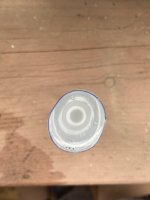I'm using Dichlor-then-bleach for a 430 gallon spa with EOS ozone generator.
Over the course of a week following water change, I added about 5.5 cumulative TBSP of Dichlor. This should have gotten me to just over 20 PPM of CYA.
However, using the 30 mL CYA test from TFTestKits I have the dot fairly visible with the test cylinder full (picture taken in shade outside on a bright day).

This causes me the following issues:
It seems like I should trust the stoichiometry and just go by the total mass of Dichlor added, and assume the CYA to be stable, and forget the test.
I'm wondering if there are good perspectives counter to that argument?
Over the course of a week following water change, I added about 5.5 cumulative TBSP of Dichlor. This should have gotten me to just over 20 PPM of CYA.
However, using the 30 mL CYA test from TFTestKits I have the dot fairly visible with the test cylinder full (picture taken in shade outside on a bright day).

This causes me the following issues:
- Not totally confident about ideal target / shock / SLAM FC levels
- Unable to track CYA stability - which should theoretically be very stable, but my spa is placed right at my outdoor landscaping so it is subject to sprinkler spray onto the cover and lots of insects that can add to contamination
It seems like I should trust the stoichiometry and just go by the total mass of Dichlor added, and assume the CYA to be stable, and forget the test.
I'm wondering if there are good perspectives counter to that argument?

